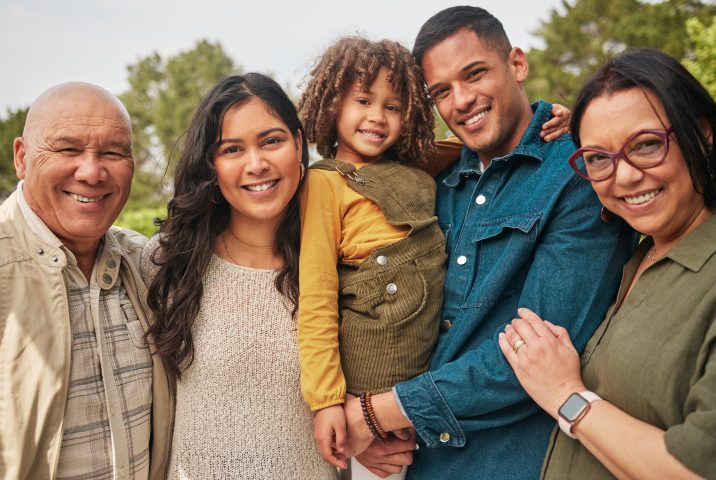
Happy family, grandparents and parent with kid in a park together and happy for vacation or outdoor vacation. Smile, portrait and mother bonding with child and father in nature for summer travel
Op-Ed
How to Facilitate Parent Involvement in Educational Decision Making for Culturally and Linguistically Diverse Families
Annette Mejer
Ph.D. Student in Teaching & Learning
July 26, 2024

For parents of students with disabilities, parent participation in the Individualized Education Programs (IEP) is a crucial part of creating meaningful partnerships through decision-making processes and appropriate IEP implementation. However, culturally and linguistically diverse (CLD) families, especially those of non-native English-speaking backgrounds, find many barriers to meaningful parent participation. Limited parent engagement in the IEP process can lead to poor student outcomes. Parents often strive for meaningful engagement in their child’s education but can be discouraged because of language barriers as it has consistently been reported that CLD families face many language barriers throughout the IEP process.
Increasing respect for language differences of CLD families must be addressed to improve partnerships and student outcomes as parent involvement annually in the IEP process is crucial to address student goals and appropriate accommodations. Unfortunately, the IEP meeting can often be very intimidating for parents from non-native English backgrounds thus hindering meaningful IEP participation . Additionally, jargon-dense language used throughout the IEP and the IEP meetings can be alienating and confusing to CLD parents. Interpreters are often used in IEP meetings to create a connection of meaningful communication between educators and parents when a common language is not shared. However, issues arise when interpreters lack knowledge about special education and the IEP process. Interpreters may not have the background knowledge to properly translate for the parent.
Recommendations
Language barriers can be addressed by improving collaboration with CLD families. Drawing from one of the key characteristics of effective collaboration in Harry’s model of cultural reciprocity, schools need to create positive and respectful relationships with CLD families. Schools need to create positive and collaborative environments where all stakeholders feel their voice and input matter. In order to create better partnerships between school and family members, schools need to intentionally create spaces where CLD families can be informed about the student’s educational and post-educational opportunities. Schools need to work with interpreters, parent advocates, and community members to elicit parent and student voice and create meaningful interactions with CLD families.
Parents of non-native English speakers often note how challenging it can be to understand the jargon used during an IEP meeting. Schools need to have interpreters fluent in the non-native language and in the jargon-dense language of special education. Interpreters can then be prepared to help explain the language used in an IEP to parents. Researchers suggest using translators who are vetted with the legal requirements and special education language. Interpreters can create ‘cheat sheets’ of common language used during in IEP meeting and make it available to the parent. The parents can familiarize themselves with the information and work with the educators and interpreters to ask questions or for clarification of any terms used. As a teacher, I have witnessed first-hand how confusing jargon from the IEP meetings can be for parents. Cheat sheets would allow for parents to be engaged and feel educated about the information shared. If schools do not have an interpreter for a specific language, digital means like Zoom conferencing can be used.
To facilitate family engagement for parents of students with and without disabilities, another strategy for including CLD parents is to utilize community supports/agencies. The school teams should take into consideration their school’s community and family demographics and work with these community organizations to connect with parents. For example, schools in Miami can turn to the United Way to find community organizations that support CLD families. United Way partners with Centro Mater Child Care Services, an organization that offers a variety of programs to improve the personal and educational outcome for Hispanic or foreign-born families that fall below the poverty line.
Further, researchers recommend having schools work with cultural brokers and local Parent Training and Information Centers to create meaningful partnerships with culturally diverse families. Cultural brokers have been defined as “advocates engaged in the purposeful act of connecting people of differing cultural background to improve collaboration”. Schools can work with cultural brokers to ensure that the information that they give parents is useful, relevant, and addresses specific cultural needs of the families. For parents of students with disabilities, cultural brokers can help with the IEP process by working with the IEP team to align goals and accommodations to specific strengths, needs, and cultural values of CLD families. Through this practice, cultural reciprocity can be developed and has the potential to improve collaborative approaches amongst schools and parents.
Schools must provide supports to facilitate meaningful engagement and foster greater understanding of Special Education. Tools that can be used include specialized interpreters, working with cultural brokers and community agencies/centers to create parent education nights informing parents of their rights, what to expect from an IEP meeting, and better understand the jargon-dense language of special education. The use of local organizations alongside cultural brokers and interpreters fosters communication that is positive and respectful. These extra steps can demonstrate that the school is committed to the success of the child. These actions have the potential to create culturally reciprocal means of communication between schools and CLD families.
References
Cavendish, W., & Connor, D. (2018). Toward authentic IEPs and Transition Plans: Student, parent, and teacher perspectives. Learning Disability Quarterly, 41(1), 32-43. https://doi.org/10.1177/0731948716684680
Compton, S. (2020). Interpreter-mediated Interactions: Parent Participation in Individualized Education Plan Meetings for deaf students from multilingual homes. Journal of Language, Identity & Education, 19(4), 227-245. https://doi.org/10.1080/15348458.2019.1649150
Harry, B. (2008). Collaboration with culturally and linguistically diverse families: Ideal versus reality. Exceptional Children, 74(3), 372- 388. https://doi.org/10.1177/001440290807400306
Rossetti, Z., Redash, A., Sauer, J.S., Bui, O., Wen, Y., & Regensburger, D. (2020). Access, accountability, and advocacy: Culturally and linguistically diverse families’ participation in IEP meetings. Exceptionality, 28(4), 243-258. https://doi.org/10.1080/09362835.2018.1480948
